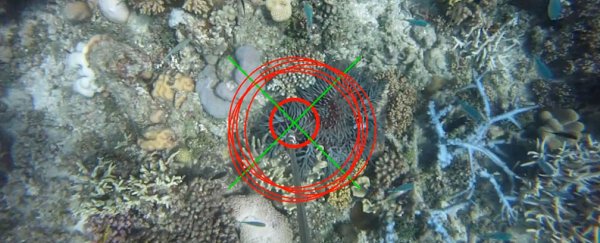If you're planning on spending any time snorkelling or scuba diving at the Great Barrier Reef this summer, try your best not to look like a starfish.
Researchers at the Queensland University of Technology (QUT) in Australia have developed the world's first Terminator-style robot designed to seek out and eliminate the crown-of-thorns starfish (COTS) that are wreaking havoc on the Great Barrier Reef's coral.
A 2012 study by the Australian Institute of Marine Science found that COTS are responsible for more than 40 percent of the decline in the reef's coral cover, thanks to huge numbers of the invertebrates munching their way through the endangered ecosystem.
The answer? Send in the COTSbot: a submarine-style killer robot specifically designed to identify and neutralise the starfish threat.
"Human divers are doing an incredible job of eradicating this starfish from targeted sites but there just aren't enough divers to cover all the COTS hotspots across the Great Barrier Reef," said Matthew Dunbabin from QUT's Institute for Future Environments, in a press release.
"We see the COTSbot as a first responder for ongoing eradication programs – deployed to eliminate the bulk of COTS in any area, with divers following a few days later to hit the remaining COTS."
 Credit: Queensland University of Technology
Credit: Queensland University of Technology
The robot can function for up to 8 hours at a time, and is equipped with 200 shots of a fatal dose of bile salts, which it delivers by extending a pneumatic injection arm in the starfish's direction.
"Its computer system is backed by some serious computational power so COTSbot can think for itself in the water," said Feras Dayoub of QUT's Science and Engineering Faculty and Australian Centre for Robotic Vision. "If the robot is unsure that something is actually a COTS, it takes a photo of the object to be later verified by a human, and that human feedback is incorporated into the robot's memory bank."
The scientists will be trialling COTSbot on living targets at the Great Barrier Reef later this month. Initial testing will involve a human, who will verify each starfish identification the robot makes before the COTSbot can proceed to terminate its target.
Autonomous tests are scheduled to commence in December, and if all goes as planned, the researchers are hopeful of finding funding to take their pest elimination system to the next level.
"The COTSbot becomes a real force multiplier for the eradication process the more of them you deploy," said Dunbabin. "[I]magine how much ground the programs could cover with a fleet of 10 or 100 COTSbots at their disposal, robots that can work day and night and in any weather condition."
Love science? Find out more about the groundbreaking research happening at QUT.
